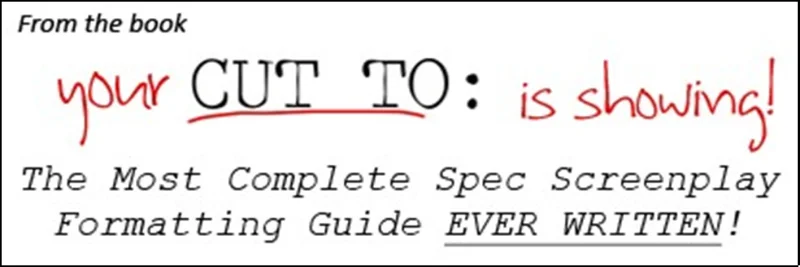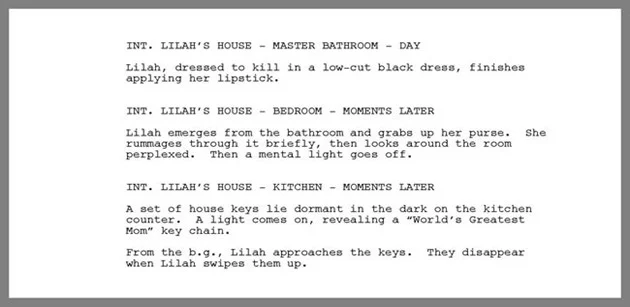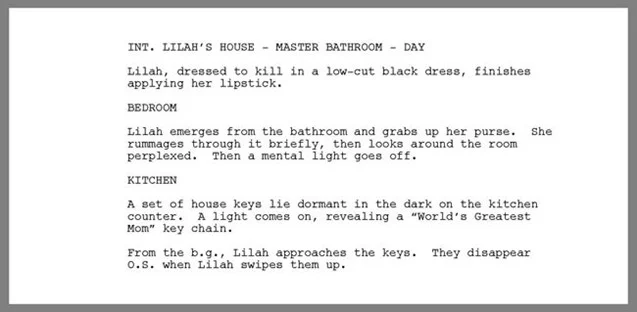
Screenwriting ABCs Script Formatting

Subheading Basics
Subheadings are similar to Master Scene Headings but are subject to them. Subheadings usually indicate small shifts in locale, camera focus, or point of view (POV).
Many of the Basic Rules surrounding Subheadings are similar to those of Master Scene Headings, with a few exceptions:
• Margins : Begin at the left margin (1.5" from page edge) and may extend all the way to the right margin (1" from right-side page edge).
• Double-space before each new Subheading. (Master Scene Headings are optionally triple-spaced before them.)
• Type in ALL CAPS.
• Double-space after each Subheading.
• If a Subheading is long enough that it must take up two lines, Single-space within the Subheading. (This should very rarely happen. Subheadings, by their nature, are short.)
• NEVER leave a Subheading at the bottom of a page. Either add a line of Direction below it, or move the Subheading to the next page. For more information, see Page Breaks.
• NEVER put Action, Sounds, or Articles (such as a, an, or the) in a Subheading.
• The ONLY exception to the ALL CAPS rule in Subheadings are for proper names such as McDonald's, DeWalt, DeVito or some name of that nature.
Subheadings vs. Master Scene Headings :
Now let's look at an example of Subheadings at work. Here is a scene that is written correctly, but uses Master Scene Headings for each and every minor scene change:

Technically there is nothing wrong with that. However, do we REALLY need to be told over and over again that we are inside LILAH'S HOUSE? Do we REALLY need to be told that the action from scene-to-scene is happening MOMENTS LATER? Isn't that information IMPLIED by the context of the scene?
Of course it is!
Here is the same scene, using Subheadings once the initial Master Scene Heading is established:

MUCH, MUCH BETTER!
Not only is it cleaner and crisper writing, but it flows better for the reader. Not to mention that we save page space with the use of Subheaders here since we double spaced before the Subheaders as opposed to the triple spaces before the Master Scene Headings in the first example.
Other Functions:
But the functionality of Subheadings doesn't stop there! Subheadings can be used in a variety of situations, including:
• Helping with the flow of Action Sequences
• POV Shots
• Inserts
• Flashbacks and Dream Sequences
• Montages and Series of Shots
Throughout the Subheading section of my book, I explore each of these uses in detail and show how to format them.
Camera Directions :
Technically, Subheadings can be used to call out Camera Directions. Doing so is actually one of the most-used functions of Subheadings. Many screenwriting experts even show you how to do it and detail the wide array of Camera Shots available for the calling out.
All that being said, a spec screenwriter should NEVER call out Camera Directions through the use of Subheadings, so I've opted not to give lessons on doing so in my book, at least where Subheadings are concerned.
However, if learning how to use Subheadings to call out Camera Directions is something you want to see done well, I might suggest The Hollywood Standard by Christopher Riley. He gives great examples of this practice, and the book itself is a great read, regardless.
----------------------
For more screenplay formatting rules and advice, check out the book, Your CUT TO: Is Showing! by T. J. Alex or visit www.scripttoolbox.com. From there, please like the page on Facebook, and share it with your friends.
If you have any formatting questions, please email T. J. at tj@tjalex.com.




